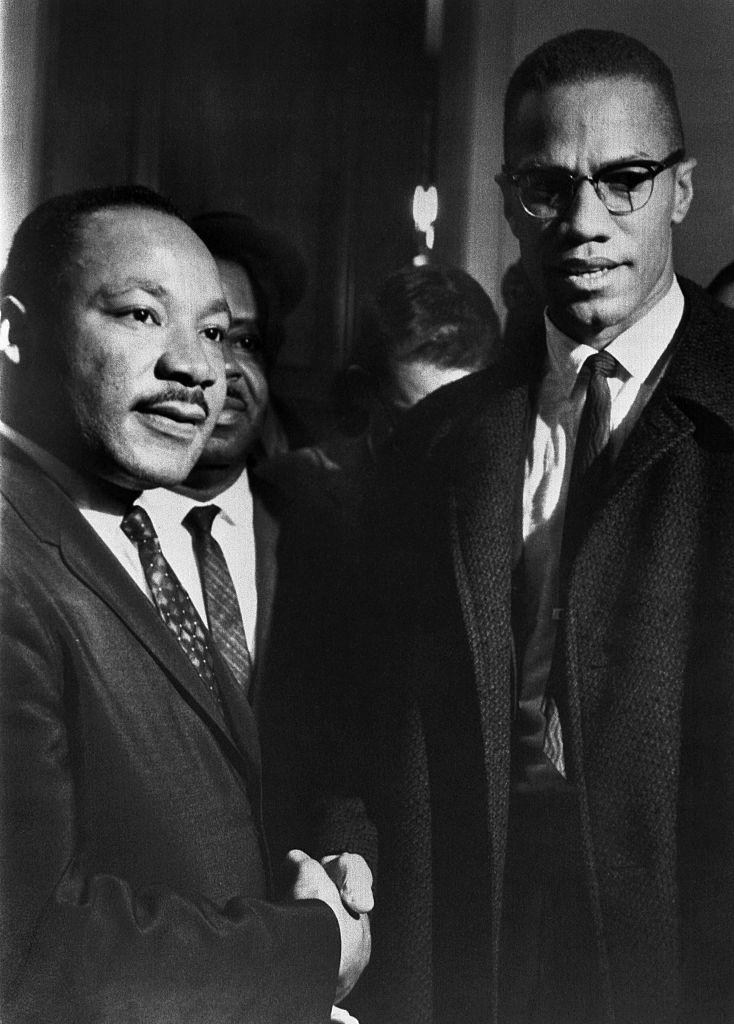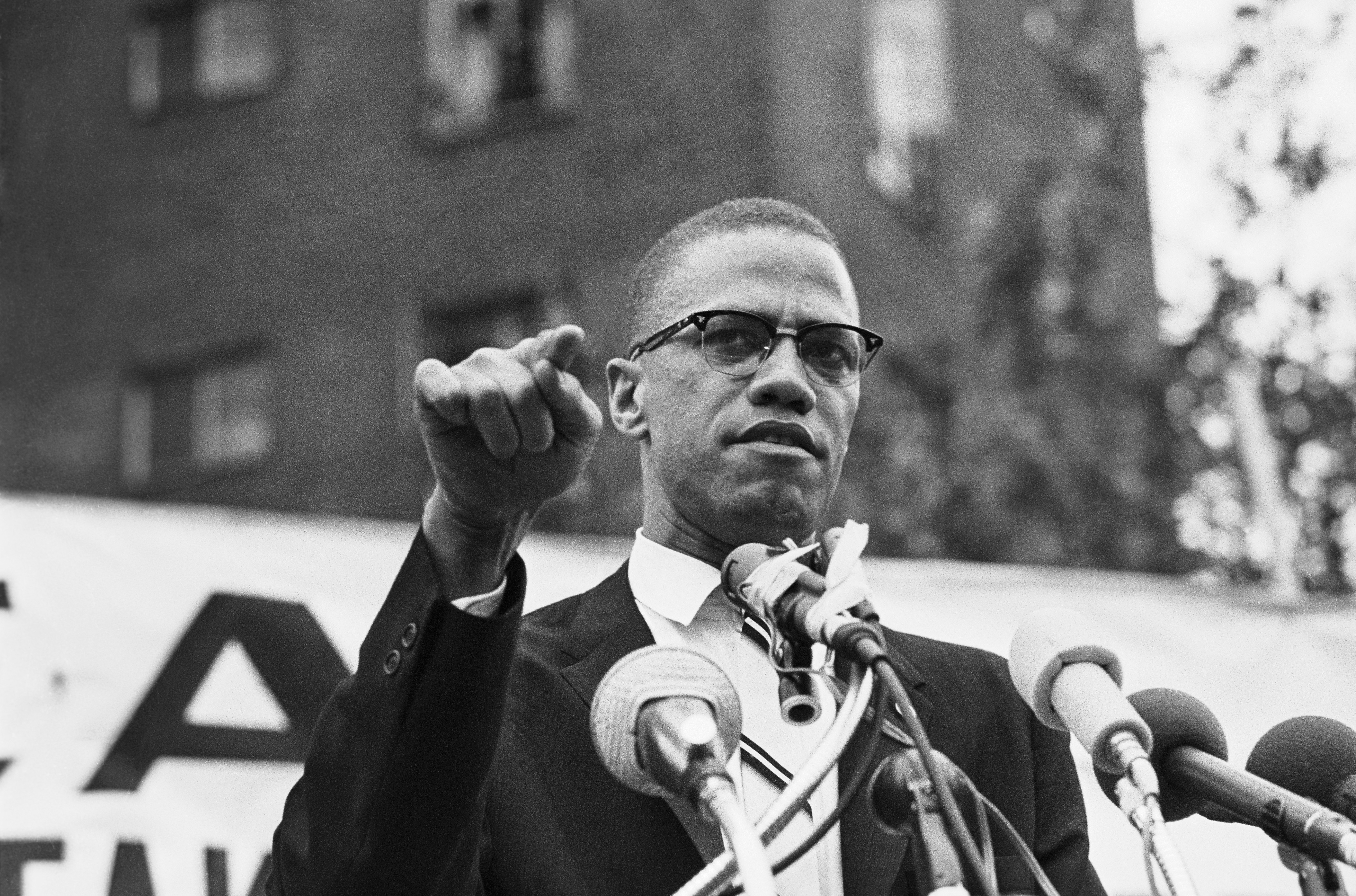The assassination of Malcolm X remains a contentious topic even decades later. WHY.EDU.VN dives deep into the circumstances surrounding his death, exploring the various theories and controversies. Discover the potential motives and the unanswered questions surrounding his untimely demise, gaining insights into the historical context and its lasting impact.
1. Who Was Malcolm X and Why Was He a Significant Figure?
Malcolm X, born Malcolm Little, was a pivotal figure in the 20th-century African American civil rights movement. His advocacy for Black empowerment, self-determination, and Pan-Africanism resonated deeply within the Black community and beyond. He challenged the prevailing narratives of racial integration, advocating for Black people to establish their own power structures and economic independence. Malcolm’s transformation from a street hustler to a powerful orator and activist made him an inspiring yet controversial figure, whose legacy continues to influence social justice movements today. His ability to articulate the frustrations and aspirations of Black Americans during a time of intense racial segregation and discrimination solidified his place as a transformative leader.
1.1 Malcolm X’s Early Life and Conversion to Islam
Malcolm X’s early life was marked by hardship and injustice. His father, a Baptist minister and advocate for Black nationalism, was allegedly killed by members of the Ku Klux Klan when Malcolm was only six years old. This traumatic event, coupled with experiences of racism and discrimination, shaped his worldview. While incarcerated for larceny and breaking and entering in the late 1940s, Malcolm embraced Islam and joined the Nation of Islam (NOI). This conversion proved transformative, providing him with a sense of identity, purpose, and a framework for understanding racial inequality.
1.2 Malcolm X’s Role in the Nation of Islam
Upon his release from prison in 1952, Malcolm X rose rapidly within the ranks of the NOI, becoming one of its most influential spokespersons and ministers. His charismatic oratory skills, sharp intellect, and unwavering commitment to Black empowerment attracted a large following to the NOI. Malcolm X’s teachings emphasized Black pride, self-reliance, and the rejection of white supremacy. He challenged the dominant narrative of racial integration, arguing that Black people should focus on building their own independent communities and institutions. While his message resonated with many, his fiery rhetoric and criticism of white society also drew criticism and controversy.
1.3 Malcolm X’s Departure from the Nation of Islam
In 1964, Malcolm X made a momentous decision to leave the Nation of Islam. Several factors contributed to this break. He became disillusioned with the moral failings of NOI leader Elijah Muhammad, including allegations of extramarital affairs. Malcolm also disagreed with the NOI’s stance of non-involvement in political activism and their failure to respond to acts of violence against Muslims. His departure marked a significant turning point in his life and ideology.
2. What Were the Circumstances Leading Up to Malcolm X’s Assassination?
The period leading up to Malcolm X’s assassination was marked by increasing tensions and threats. After leaving the NOI, Malcolm faced animosity and death threats from former allies within the organization. His public criticisms of Elijah Muhammad and the NOI’s leadership made him a target. Additionally, Malcolm was under constant surveillance by the FBI and other government agencies, who viewed him as a subversive figure. These factors created a climate of danger and uncertainty that ultimately culminated in his assassination.
2.1 Malcolm X’s Growing Disagreements with the Nation of Islam
Malcolm X’s departure from the NOI was fueled by several key disagreements. He was troubled by Elijah Muhammad’s personal conduct and the NOI’s strict adherence to a policy of non-engagement in politics. Malcolm believed that the NOI should actively address the social and political injustices faced by Black Americans. He also expressed concerns about the NOI’s financial practices and the lavish lifestyle of its leaders. These disagreements created a growing rift between Malcolm and the NOI, leading to his eventual break from the organization.
2.2 The Formation of Muslim Mosque, Inc. and the Organization of Afro-American Unity
Following his departure from the NOI, Malcolm X established two new organizations: Muslim Mosque, Inc. (MMI) and the Organization of Afro-American Unity (OAAU). MMI was a religious organization focused on promoting orthodox Islam within the Black community. The OAAU was a secular organization dedicated to advocating for the civil and human rights of Black people in the United States and around the world. These organizations provided Malcolm with a platform to continue his activism and promote his evolving ideology of Black liberation.
2.3 Threats and Surveillance
Malcolm X’s activities after leaving the NOI drew the attention of both his former allies and the U.S. government. He received numerous death threats from members of the NOI, who viewed him as a traitor. Additionally, Malcolm was under constant surveillance by the FBI, which had been monitoring him for over a decade. The FBI saw Malcolm as a potential threat to national security and sought to undermine his work through surveillance, informants, and other covert tactics. This combination of threats and surveillance created a dangerous environment for Malcolm and contributed to the circumstances leading to his assassination.
Malcolm X and Martin Luther King met briefly on March 26, 1964, during a Senate debate on the Civil Rights Act.
3. What Exactly Happened on the Day of Malcolm X’s Assassination?
On February 21, 1965, Malcolm X was assassinated while delivering a speech at the Audubon Ballroom in Harlem, New York City. As he began his address, a commotion erupted in the audience, creating a distraction. Amidst the chaos, several gunmen rushed the stage and opened fire on Malcolm X. He was struck multiple times and died shortly thereafter. The assassination sent shockwaves through the Black community and the nation, marking a tragic loss of a prominent voice for Black empowerment.
3.1 The Setting: The Audubon Ballroom
The Audubon Ballroom, located in the Washington Heights neighborhood of Harlem, was a significant cultural and community center for the Black community in New York City. It served as a venue for rallies, dances, and other events. Malcolm X frequently spoke at the Audubon Ballroom, making it a symbolic location for his activism. The choice of the Audubon Ballroom as the site of his assassination suggests that the perpetrators sought to strike a blow at the heart of Malcolm’s movement.
3.2 The Assassination
According to eyewitness accounts, as Malcolm X approached the podium, a disturbance broke out in the crowd. Amidst the commotion, a man rushed forward and shot Malcolm X in the chest. Two other men then joined in, firing multiple shots at Malcolm. The assassination was swift and brutal, leaving Malcolm mortally wounded. The chaotic scene made it difficult to identify the perpetrators immediately.
3.3 Immediate Aftermath
Following the assassination, chaos erupted in the Audubon Ballroom. Members of Malcolm X’s security team and audience members attempted to apprehend the gunmen. One of the assassins, Talmadge Hayer (also known as Thomas Hagan or Mujahid Abdul Halim), was shot in the leg by Malcolm’s security and apprehended at the scene. The other assailants managed to escape. Malcolm X was rushed to a nearby hospital but was pronounced dead shortly after arrival.
4. What Was the Outcome of the Investigation Into Malcolm X’s Murder?
The investigation into Malcolm X’s assassination led to the arrest and conviction of three members of the Nation of Islam: Talmadge Hayer, Norman Butler (also known as Muhammad Abdul Aziz), and Thomas Johnson (also known as Khalil Islam). All three men were found guilty of murder and sentenced to life in prison. However, the investigation has been plagued by inconsistencies and questions, leading some to believe that the full truth about Malcolm X’s assassination has yet to be revealed.
4.1 The Arrest and Conviction of Talmadge Hayer, Norman Butler, and Thomas Johnson
Talmadge Hayer, who was apprehended at the scene of the assassination, confessed to participating in the crime but maintained that Butler and Johnson were not involved. Despite Hayer’s testimony, all three men were convicted based on eyewitness identifications and their affiliation with the Nation of Islam. The prosecution argued that Malcolm X’s assassination was the result of a conspiracy within the NOI to silence a dissenting voice.
4.2 Doubts and Inconsistencies in the Case
Over the years, doubts have emerged regarding the fairness and thoroughness of the investigation into Malcolm X’s assassination. Witnesses have recanted their identifications of Butler and Johnson, and evidence has surfaced suggesting that other individuals may have been involved in the plot. The lack of a thorough investigation into these alternative leads has fueled suspicions of a cover-up.
4.3 Recent Developments: Re-examination of the Case
In recent years, there has been renewed interest in the Malcolm X assassination case. A Netflix documentary series, Who Killed Malcolm X?, has brought fresh attention to the unresolved questions and inconsistencies surrounding the investigation. The Manhattan District Attorney’s Office has announced that it will review the case, working with the Innocence Project to examine new evidence and potential leads. This re-examination offers hope that the truth about Malcolm X’s assassination may finally be revealed.
Talmadge Hayer (Thomas Hagan) was caught at the scene of the crime after being shot in the leg.
5. Why Do Some Scholars Advocate for Reopening the Malcolm X Assassination Case?
Scholars and historians have long argued for the reopening of the Malcolm X assassination case due to lingering doubts and inconsistencies in the official narrative. Some believe that the investigation was inadequate and that key evidence was overlooked or suppressed. Others suspect that government agencies may have played a role in the assassination or its cover-up. Reopening the case could provide an opportunity to uncover new evidence, re-examine existing evidence, and potentially bring justice to those who were wrongly convicted or involved in the crime.
5.1 Allegations of Government Involvement
One of the main reasons for advocating for the reopening of the Malcolm X assassination case is the persistent allegation of government involvement. Some researchers point to the FBI’s extensive surveillance of Malcolm X and its efforts to undermine his work as evidence of a potential conspiracy. They argue that the FBI may have been aware of the plot to assassinate Malcolm X but did not intervene or may have even facilitated the assassination. Declassified documents and eyewitness accounts have fueled these suspicions, prompting calls for a thorough investigation into the role of government agencies in Malcolm X’s death.
5.2 The Potential for New Evidence
Another reason for reopening the case is the possibility that new evidence may emerge that could shed light on the truth about Malcolm X’s assassination. Over the years, new witnesses have come forward, and previously unseen documents have been uncovered. These new sources of information could provide valuable insights into the events leading up to the assassination and the identities of those involved. Reopening the case would allow investigators to pursue these new leads and potentially uncover evidence that was not available during the original investigation.
5.3 Seeking Justice and Closure
Ultimately, the push to reopen the Malcolm X assassination case is driven by a desire for justice and closure. Many believe that the truth about Malcolm X’s death has been suppressed for too long and that those responsible for the crime should be held accountable. Reopening the case would provide an opportunity to correct the historical record, exonerate those who were wrongly convicted, and bring a sense of closure to the Black community and the nation as a whole.
6. What is Malcolm X’s Enduring Legacy?
Malcolm X’s legacy continues to inspire and influence social justice movements around the world. His advocacy for Black empowerment, self-determination, and Pan-Africanism remains relevant in the face of ongoing racial inequality and injustice. Malcolm X’s teachings have shaped the Black Power movement, the Black Lives Matter movement, and other efforts to challenge systemic racism and promote Black liberation. His life and message serve as a reminder of the importance of fighting for equality and justice, even in the face of adversity.
6.1 Influence on the Black Power Movement
Malcolm X’s teachings had a profound impact on the Black Power movement, which emerged in the mid-1960s. The Black Power movement embraced Malcolm X’s emphasis on Black pride, self-reliance, and the need for Black people to control their own communities and institutions. Organizations such as the Black Panther Party drew inspiration from Malcolm X’s ideas and sought to implement his vision of Black empowerment through community organizing, self-defense, and political activism.
6.2 Impact on Contemporary Social Justice Movements
Malcolm X’s legacy continues to resonate in contemporary social justice movements, particularly the Black Lives Matter movement. Black Lives Matter has adopted Malcolm X’s critique of systemic racism and his call for Black people to assert their rights and demand justice. The movement’s focus on police brutality, racial profiling, and other forms of racial discrimination reflects Malcolm X’s analysis of the ongoing challenges facing Black Americans.
6.3 Malcolm X as a Symbol of Resistance
Malcolm X has become a symbol of resistance against racial oppression and injustice. His image and words are frequently invoked in protests, rallies, and other forms of activism. Malcolm X’s unwavering commitment to Black liberation and his willingness to challenge the status quo continue to inspire people of all backgrounds to fight for a more just and equitable world.
Malcolm X’s speeches emphasized Black pride and self-determination.
7. FAQ About the Assassination of Malcolm X
Here are some frequently asked questions concerning Malcolm X’s death:
| Question | Answer |
|---|---|
| Who was convicted of assassinating Malcolm X? | Talmadge Hayer, Norman Butler, and Thomas Johnson, all members of the Nation of Islam, were convicted of his murder. |
| Why did Malcolm X leave the Nation of Islam? | He became disillusioned with the NOI’s leadership, particularly Elijah Muhammad, and disagreed with their political stance. |
| Was there government involvement in Malcolm X’s assassination? | Allegations of government involvement persist, though no conclusive evidence has been found. |
| What was Malcolm X’s message? | He advocated for Black empowerment, self-determination, and Pan-Africanism. |
| How did Malcolm X influence the Civil Rights Movement? | He offered a more radical and separatist approach compared to the integrationist views of other leaders. |
| What is the significance of the Audubon Ballroom in his story? | It was the location where he was assassinated, a place where he often spoke. |
| What role did the FBI play in Malcolm X’s life? | The FBI closely monitored him and his activities, viewing him as a threat. |
| What is the current status of the investigation into his assassination? | The Manhattan District Attorney’s Office has reopened the case for review. |
| What is Malcolm X’s legacy today? | He remains an icon of Black liberation and a key figure in understanding racial dynamics in America. |
| Were the convicted assassins truly responsible? | Doubts persist, with some claiming they were wrongly accused or that there were other individuals involved. |
| What motivated Malcolm X’s activism? | A desire to address racial inequality and empower Black communities. |
| How did Malcolm X’s views evolve over time? | He shifted from a more separatist stance to one of international solidarity and broader human rights. |



8. Conclusion: The Unresolved Questions Surrounding Malcolm X’s Death
The assassination of Malcolm X remains a complex and controversial event in American history. While three men were convicted of the crime, questions persist about the full truth behind his death. Allegations of government involvement, inconsistencies in the investigation, and the potential for new evidence continue to fuel calls for a reopening of the case. Regardless of the unresolved questions, Malcolm X’s legacy as a champion of Black empowerment and a symbol of resistance against racial injustice endures.
8.1 Why Further Investigation Matters
Further investigation into the Malcolm X assassination case is crucial for several reasons. First, it could help to uncover the truth about who was responsible for his death and bring justice to those who were wrongly convicted or involved in the crime. Second, it could shed light on the role of government agencies in the assassination and expose any potential wrongdoing. Finally, it could provide a sense of closure to the Black community and the nation as a whole, allowing for a more complete understanding of this pivotal moment in American history.
8.2 The Search for Truth and Justice Continues
The search for truth and justice in the Malcolm X assassination case is ongoing. As new evidence emerges and old questions are re-examined, there is hope that the full story of his death will eventually be revealed. In the meantime, Malcolm X’s legacy serves as a reminder of the importance of fighting for equality and justice, even in the face of adversity.
Do you have more questions about Malcolm X and his assassination? Or perhaps you’re curious about other historical events or complex social issues? At WHY.EDU.VN, we are committed to providing accurate, in-depth answers to all your questions. Our team of experts is dedicated to exploring a wide range of topics, from history and science to current events and culture. Visit why.edu.vn today to ask your questions and discover a wealth of knowledge. Contact us at 101 Curiosity Lane, Answer Town, CA 90210, United States. Whatsapp: +1 (213) 555-0101.
